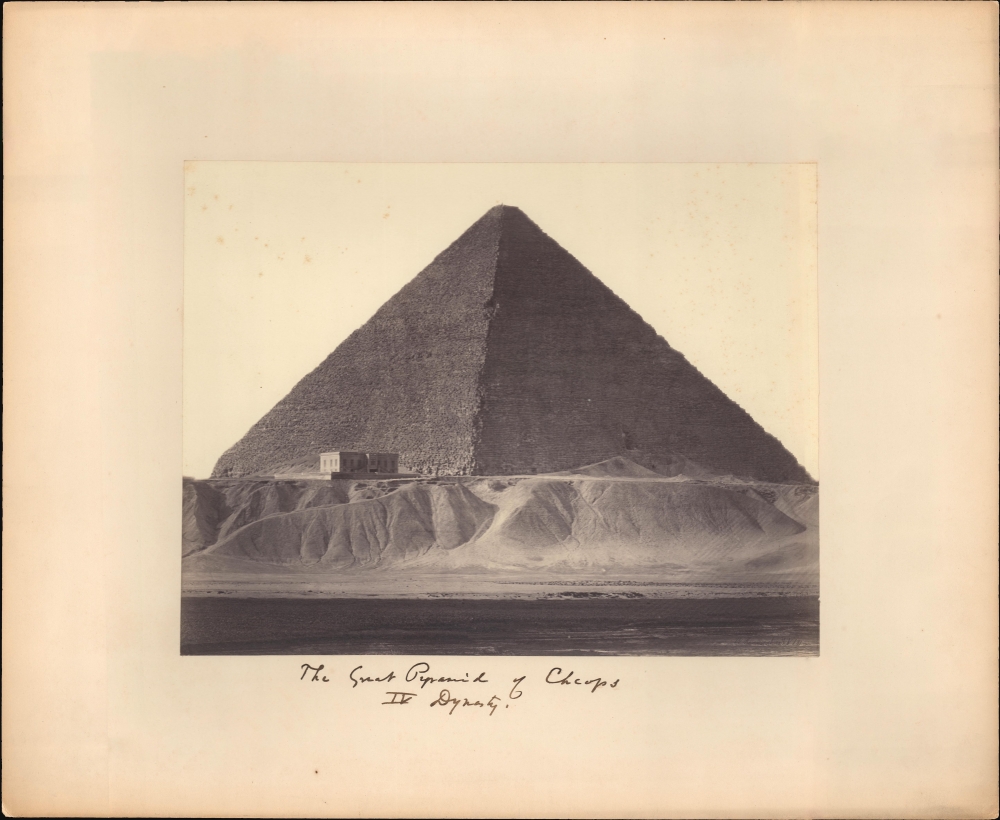1861 Hammerschmidt Albumen Silver Print Photograph: Great Pyramid, Giza, Egypt
GreatPyramid-hammerschmidt-1861
Title
1861 (undated) 14 x 17 in (35.56 x 43.18 cm)
Description
Great Pyramid of Khufu
The Great Pyramid of Khufu, also known as the Pyramid of Cheops, is the largest and most famous of the pyramids in the Giza pyramid complex, Egypt. Built as a tomb for the IV Dynasty Egyptian Pharaoh Khufu around 2580-2560 BC, it is a marvel of ancient engineering and architectural genius. Constructed from approximately 2.3 million blocks of stone, each weighing an average of 2.5 tons, the pyramid originally stood at 146.6 meters (481 feet), although it now measures around 138.8 meters (455 feet) due to the loss of the outer casing stones. The precise methods used in its construction remain a subject of research and debate. The Great Pyramid was originally covered with casing stones that formed a smooth outer surface; what is seen today is the underlying core structure. It was the tallest man-made structure in the world for over 3,800 years and is considered one of the Seven Wonders of the Ancient World.Provenance
These images were from the collections of Roswell Dwight Hitchcock (1817 - 1887). Hitchcock was a congregationalist minister and professor at Bowdoin and later at the Union Theological Seminary in New York. His ministry took him to Germany in the 1840s. Afterwards, he visited Italy and Greece in 1866; and in 1869 and 1870 he traveled to Egypt and Palestine. He was appointed president of the American Palestine Exploration Society in 1871, and vice-president of the American Geographical Society in 1880. Whether he acquired these before traveling to Egypt, there, or on his way back to America, is unknown.Publication History and Census
Scarce. We see a single other example of this photograph, located at the Griffith Institute.Cartographer
Wilhelm Hammerschmidt (March 3, 1822 - August 26, 1887) was a German photographer best known for his photographs of Egypt, Sudan, and Nubia. Hammerschmidt was born in Berlin. He lived in Berlin until about 1860, when he relocated to Cairo, Egypt, to open a photo studio. He offered a service whereby he would travel with tourists as a companion, taking both studio photographs and photos in front of Egypt's historic ruins. His travels in the country took him up the Nile to Abu Simbel in Upper Egypt and further to Nubia and what is now Sudan. He was a member of the Deutschen Photographischen Gesellschaft (German Photographic Society). His photos of Egyptian ruins were well received in 1861 at the Société Française de Photographie and in 1862 at the London International Exhibition of Industry and Art. Back in Egypt, he ran into trouble when attempting to photograph Islamic pilgrims on the Hajj, wherein he was attacked and injured. He returned to Berlin in 1863, oping a studio at Potsdamer Strasse 51, where he remained until 1883. He also briefly entered politics and served as a community leader from 1881 to 1882. Today, his photographs are considered his primary legacy, and are included in some of the world's most prestigious museums, including the Bibliothèque Nationale de France (BnF), the Getty Museum, and the Metropolitan Museum of Art. More by this mapmaker...

